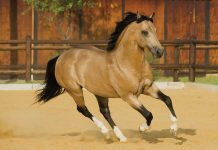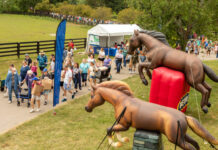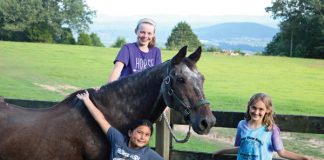
A jumper course usually has 9 or 10 fences in them. The fences are usually colorful and they may have patterns on them. You will jump walls, panels and roll tops. The course may be difficult, with double and triple fences, tough turns and twisty paths.
There are jumper classes for every jumping level. If you or your horse is a novice jumper, look for shows that hold two foot and two foot six inch classes.
If you make it through the first round clear, you’ll move on to the jump-off. The jump off usually consists of less fences than the first round—usually five or six fences. They will be fences you jumped in the first round so your horse will have seen them already.
The most important thing in the jump-off is speed. You want to get around the course more quickly than the other competitors. This means you may have to cut corners and jump fences at an angle to save time, but you also want to jump clear. The fastest round with the fewest faults wins.
Here are some things you can do to get ready for jumper classes.
1. Practice at home
You can practice jumper classes at home. Set up a jumper-type course with your trainer or a horsey adult. It should have a double and a triple combination and the fences should be as colorful as you can make them. If you don’t have any “interesting” fillers, hang blankets over the top pole of a fence. Set up a roll back jump—this when you jump a fence and then have to turn back and jump another. Place two fences on a bended line–this means you jump one fence and have to canter forward on a curve to the right or left to jump the next fence.
2. Walk the jumper course
At smaller shows you may not get the chance to walk your jumper course. You’ll just get to look at the course map by the ring. But at bigger shows, you’ll get a few minutes to walk the class. Practice walking the course at home. Go into the arena and walk the course as you intend to jump it.
Look at each fence and think about what lead you need to be on to approach it correctly. You want your horse to change leads over the fence or do a flying change, because slowing down to change your lead between fences may lose you a ribbon!
Think about where you can save time. Can you gallop inside a fence, instead of going the long way around it? Can you approach a fence diagonally instead of looping around to face it straight on?
3. You don’t have to do a courtesy circle in jumper classes.
Most riders just pick up the canter after they hear the judge’s bell and aim for the first fence on the course.
4. Look to the next fence
When you jump a fence, look to the next fence on the course. Even though you might not realize it, your weight shifts when you turn your head and this weight shift can give the signal to your horse realize that he’s going to turn after he lands.
5. Turn over the fence
If your horse is an experienced jumper, save time by turning him as you jump a fence so when he lands he’s heading toward the next fence on the course. Practice this skill over little verticals. If your next fence is to the left, squeeze with your left rein, keep your left leg at the girth and put your right leg behind the girth to help your horse bend over the fence.
When he lands, head for the next fence.
6. Jumping at an angle
Sometimes you can save time on a course by jumping fences on a diagonal line, instead of straight on, perpendicular to the fence as you usually do. Practice jumping on the diagonal.
Set up a small vertical and approach it at an angle. Imagine a straight line crossing the fence at a diagonal and stick to that line as you approach the fence. It might help you to look at a fence pole or a tree in the distance.
7. Roll backs
You may have to jump a fence and then turn your horse around and jump another one in the other direction. This is known as a roll back. Place two small jumps in a v-shape in your arena. Approach the first fence and aim for the middle. After your horse land, ask him to turn in a small loop to approach the second fence.
Don’t get rough with your horse and just yank him around the turn. Stay quiet and use the correct signals to ask him to bend around your inside leg.
Once your horse has turned, straighten him out by keeping your hands and reins even and then aim for the next fence. Give him a squeeze with your legs to keep him moving forward.
At first, your turn may be quite large, but once your horse figures out his job, you’ll be able to make the turn smaller.
Practice rollback turns at the trot a few times before you try them at the canter.
8. Ride close to the jump standards
In a hunter class, you ride around a jump standard, giving yourself plenty of room to approach the next fence. In a jumper class you are trying to go fast, so you might need to cut some corners to save time. This means that you may ride close to a jump standard to save seconds. Practice this at home so your horse gets used to riding close to the fences.
You don’t want him spooking at a jump standard when you whiz by it at a show.
9. Don’t Look Back!
If you think you knocked a rail down, don’t look back! Looking back the fence you’ve just jumped can slow down your horse and distract you from the next fence. Just kick on and aim for the next fence!
10. The Finish Line
Know where the finish line is and remember to gallop through it. Don’t jump the last fence and slow down to a relaxed walk. Keep going fast until you’re safely past the finish line and timer.
This article originally appeared in the July/August 2008 issue of Young Rider magazine. Click here to subscribe!





